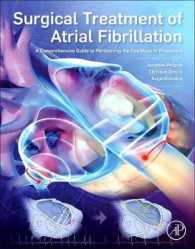Full Description
The Psychology of Criminal Behaviour is a thrilling and comprehensive introduction to the psychological theories of criminality and violence. It examines how psychology and biology both play a role in understanding what may lead individuals to commit crime. Theoretical in approach, The Psychology of Criminal Behaviour ensures that material is presented in a way that meets the needs of both psychology and criminology students. The text includes exciting case studies and research boxes, chapter introductions and summaries, a marginal glossary, and thoughtful review questions to enhance student understanding and engagement. From genetic influences to developmental theories, serial killers to stalkers, the text applies relevant research and real-world examples, creating an exciting and inclusive introduction to the field.
Contents
Note: Each chapter includes:
- Learning objectives
- Chapter-opening case study
- Introduction
- Bolded key terms
- Marginal glossary
- Researching Criminal and Violent Behaviour boxes
- Chapter summary
- Review questions
- Additional reading
Preface
Acknowledgments
1. Introduction
Case Studies
What Is Criminal Behaviour?
The Sociological Construction of Crime
Case Study: Robert Bardo
Violent Behaviour
Theoretical Perspectives
Scientific Theories
Organization of This Book
2. Genetics and Evolution
Case Study: Jeffrey Landrigan
Behavioural Genetics
Case Study: The Kray Brothers
Putting It All Together: Genetic Predispositions and Behavioural Destiny
Evolution
Case Study: Christopher Rocancourt
Sex Differences
Age-Crime Curve
3. Biology
Case Study: Chris Benoit
The Structure of the Brain
Brain Injury and Criminal Behaviour: General Evidence
Brain Plasticity and Early Head Injury
Specific Brain Regions and Criminal Behaviour
Case Study: Phineas Gage
Case Study: Charles Whitman
Putting It All Together: The Prefrontal Cortex and Limbic System
Lateralized Hemispheric Dysfunction
Putting It All Together: The Findings on Lateralization
Neurochemistry and Criminality
Putting It All Together: Neurotransmitters and Aggression
Psychophysiology and Crime
4. Developmental Pathways
Case Study: Ethan Couch
The Stability of Criminal Behaviour
Major Developmental Theories
Early Childhood Factors and Delinquency
Parental Practices and Delinquency
Peer and School Factors
5. Personality
Case Study: Dr. Amy Bishop
The Nature of Personality
Psychodynamic Theories of Personality
Attachment and Personality
Case Study: Aileen Wuornos
The Trait Perspective
Personality Disorders
Case Study: Rorschach
6. Psychopathy
Case Study: Clifford Robert Olson
The Clinical Description of Psychopathy
Case Study: Adremy Dennis
Assessing Psychopathy
Empirical Links between Psychopathy and Criminal Behaviour
Case Study: "Dave"
Psychopathy and Gender
Case Study: Joanna Dennehy
Psychopathy and Crime across the Lifespan
Psychopathy across Culture
Theoretical Explanations of the Psychopathy-Crime Link
Putting It All Together: A "Perfect Storm" for Crime
7. Learning
Case Study: Devalon Armstrong
Classical Conditioning
Case Study: Richard Ramirez
Operant Conditioning
Observational Learning
The Effects of Violent Media
Differential Association-Reinforcement Theory
Case Study: Henry Hill
Putting It All Together: DA-Reinforcement Theory in Action
8. Social Cognition
Case Study: Umar Farouk Abdulmutallab
Moral Reasoning
Moral Disengagement
Criminal Thinking
Hostile Thoughts and Affect
Social Interactions
Case Study: Lynndie England and US Military Personnel at Abu Ghraib
Social Information Processing Theories
Enactment of Antisocial and Violent Behaviours
Case Study: George Zimmerman and Trayvon Martin
Putting It All Together: The General Aggression Model
9. Mental Disorder
Case Study: Rene Poole
Systems for Classifying Mental Disorders
Major Mental Disorders
Mental Disorder and Crime
Putting It All Together: The Relationship of Mental Disorder and Crime in Context
The Criminalization of Mental Disorder
Putting It All Together: Making Sense of Criminalization
Symptom-Based Theories of Crime
Case Study: Margaret Mary Ray
Case Study: Vincent Li
Factors Influencing the Relationship between Mental Disorder and Crime
Mental Disorder Creates "Tense Situations" That Lead to Violence
10. Substance Use
Case Study: Robert Osborne
Drug Use and Its Effects
Major Classes of Drugs
Goldstein's Tripartite Model
Case Study: Pablo Escobar
Putting It All Together: Making Sense of Psychopharmacological Violence
Theories of the Alcohol-Violence Relationship
Case Study: Shia LaBeouf
Putting It All Together: Integrating Theories of Alcohol-Related Aggression
11. Homicide
Case Study: The Manson Family Murders
Theoretical Models of Homicide
Case Study: The La Loche Shooter
Homicide in the Family
Multiple Murder
Case Study: The Green River Killer
Case Study: The Jonestown Massacre
Case Study: Adam Lanza and the Sandy Hook Elementary School Shooting
12. Interpersonal Violence
Case Study: Ray Rice
Stalking
Intimate Partner Violence
Theories of Stalking and Intimate Partner Violence
Sexual Violence
13. Assessment and Treatment
Case Study: Karla Homolka
Risk of Offending
Risk Assessment of Offenders
The Clinical Versus Actuarial Debate
Putting It All Together: Good Risk Assessment Practices
Treatment of Offenders
Case Study: Darnell Pratt and Brendan Sarginson
How Effective Are Offender Treatment Programs?
Putting It All Together: Effective Programs in Practice
Glossary
References
Index








